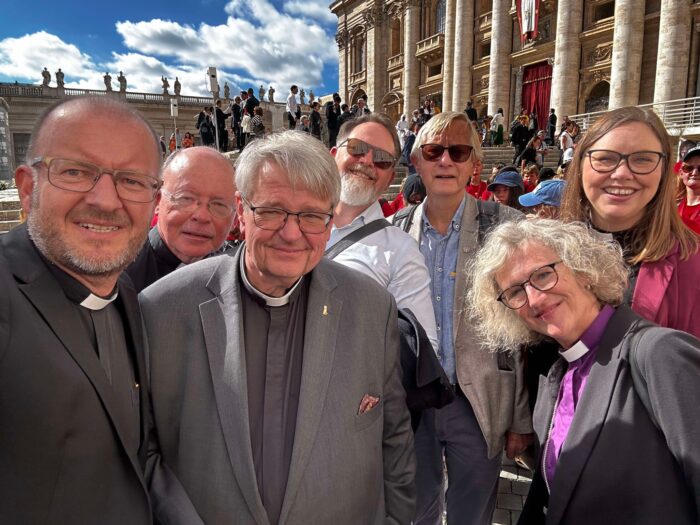Flere brev fra bispesynoden
Jeg skrev for et par uker siden om en spesiell type rapporter fra bispekonferansen i Rom i høst. I alt er det publisert 12 slike brev fra «Xavier Rynne II», her er de siste:
12/10 – BREV 6
14/10 – BREV 7
17/10 – BREV 8
19/10 – BREV 9
22/10 – BREV 10
25/10 – BREV 11
28/10 – BREV 12
I oppsummeringen i brev 12 får ikke denne bispesynoden veldig gode karakterer:
Overhyped
The hype surrounding the three-year “synodal process” of 2021–2024 began with the Synod leadership itself. In numerous interviews, Synod general secretary Cardinal Mario Grech and the Synod relator general, Cardinal Jean-Claude Hollerich, S.J., insisted that, thanks to the “synodal experience,” the “People of God are on the move”—as if the People of God had not been “on the move” since the first Christian Pentecost; as if the Church had been stalled and spinning its wheels in the decades after the Second Vatican Council. That self-congratulatory and self-satisfied usage fit snugly within the cast of mind of such as Fr. Thomas Reese, S.J., who recently wrote, evidently without blushing, a daffy history of the Church since 1962: “The Church has gone through the revolutionary reforms of the Second Vatican Council, followed by the repressive regimes of John Paul and Benedict. Francis has once again opened the Church to free discussion . . .” And if this was how the Synod managers and the progressisti of Catholic journalism were thinking, it was unsurprising that the Washington Post’s Anthony Faiola should describe Synod-2024 as “the most significant Catholic gathering since the 1960s.” – What nonsense.
Any number of World Youth Days have had a far more enduring impact on the life of the Church than Synod-2024 will likely have. World Youth Day-1993 in Denver was a critical turning point in the life of American Catholicism, and its effects are still being felt through evangelical, catechetical, and pastoral outgrowths of that experience like the Fellowship of Catholic University Students (FOCUS) and the Augustine Institute, and through the innumerable priestly and religious vocations, and vocations to holy matrimony, inspired by WYD-1993.
The Extraordinary Synod of 1985, which marked the twentieth anniversary of the conclusion of the Second Vatican Council, found the master key that unlocked the treasure chest of the “council without keys” and integrated the riches of Vatican II in its description of the Church as a communion of disciples in mission. The living parts of the world Church embraced that way of thinking and embodied it in mission and evangelization. …
Et annet negativt element nevnes også:
Overmanaged
Before the Synod on Synodality fades further in the rear-view mirror, it’s important to confront another myth about the “synodal process”: namely, that it was uniquely open, transparent, dialogical, and unprecedented in scope. – More nonsense.
The consultations leading up to the Synods at the parish, diocesan, national, and continental levels never engaged more than, at most, 1 percent of the world’s 1.3 billion Catholics, many of whom were more interested in getting on with their lives as missionary disciples than in sitting through small-group discussions dominated by the agenda-driven. …
På tross av dette påpekes noe positivt:
Providentially Heartening
For this synodal process between 2021 and 2024 has some real accomplishments to its credit. It has allowed firm new friendships to form on a global basis among leaders of the living parts of the world Church, both clergy and lay.
It has decisively clarified the fact that, despite the thirty-five years of brilliant magisterium created by John Paul II and Benedict XVI, there remain significant voices within the Church promoting the theological, moral, and pastoral agenda of Catholic Lite. In the debate over the Catholic future, all the cards are now out on the table—and it is clear which hands are playing which cards. That the dying parts of the world Church are those who remain committed to the Catholic Lite agenda and its absorption of the spirit of the age has been made unmistakably clear. And while some may find it strange, even bizarre, that this process has been led by men and women from rather moribund parts of the world Church, others, arguably more prescient, have found this usefully clarifying, too.
That the Catholic Lite agenda at Synod-2024—the affirmation of the teaching authority of national bishops’ conferences, the endorsement of a female diaconate understood as part of Holy Orders, the LGBTQ+ program, proportionalist moral theology that dumbs down the moral life—did not gain anything resembling consensus, even in a Synod as carefully arranged and managed as this one, can only be, as one bishop said, the work of the Holy Spirit. …

